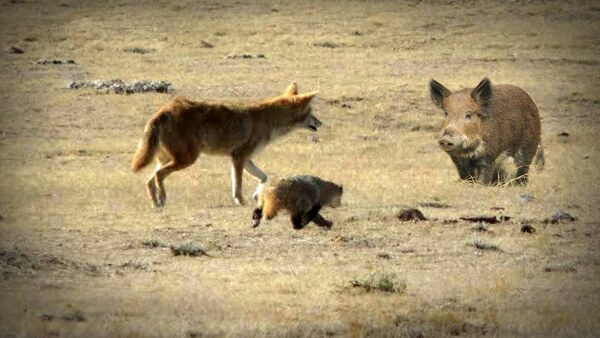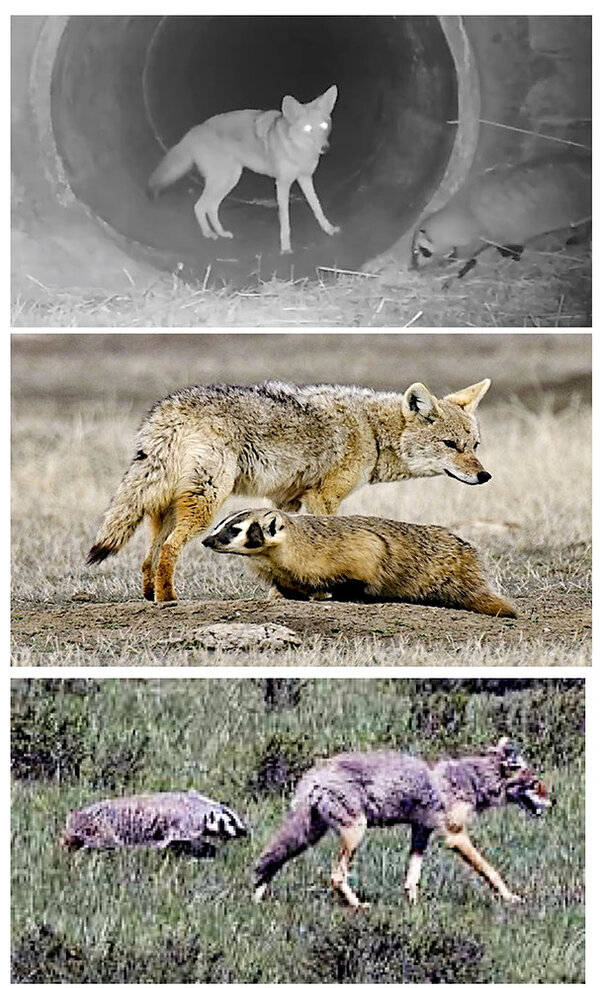In the natural world, cooperation between species is rare but captivating. One of the most intriguing examples is the partnership between coyotes and badgers. These two predators often team up to hunt, showcasing a fascinating mutualistic relationship. This article delves into the reasons behind their cooperation, the hunting strategies they employ, and the ecological importance of such interspecies collaboration.

Coyotes (Canis latrans) and badgers (Taxidea taxus) have developed an unexpected partnership that combines their strengths to enhance hunting success. While they are independent predators, their collaboration is a prime example of mutualism in the animal kingdom.
Complementary Skills:
Coyotes excel in speed and endurance, chasing down prey in open spaces, while badgers are adept diggers, skilled at extracting prey from underground burrows. Together, they cover both terrains effectively.
Shared Prey:
Both animals primarily hunt rodents, such as ground squirrels and prairie dogs. By combining forces, they can exploit prey more efficiently than hunting alone.
Increased Success Rates:
Studies have shown that this partnership increases their hunting success, as prey that escapes one predator may fall victim to the other.
This relationship is a form of facultative mutualism, where both species benefit but are not entirely dependent on each other. When hunting together, the coyote and badger communicate through body language and movements, coordinating their actions to trap prey.

The hunting methods of coyotes and badgers highlight their remarkable teamwork.
Coyote’s Role:
Chasing Prey: Coyotes rely on their speed to chase prey across open fields.
Flushing Out Rodents: They often circle burrows, causing rodents to flee underground where badgers are waiting.
Badger’s Role:
Excavating Burrows: With powerful claws and a muscular body, badgers dig out prey hiding in tunnels.
Blocking Escape Routes: Badgers can also prevent rodents from escaping burrows while coyotes patrol above ground.
Combined Tactics:
Tag Teaming Prey: If prey escapes one predator, it often runs straight into the path of the other. This complementary strategy ensures higher success rates for both species.
Coyotes and badgers represent a rare example of interspecies cooperation among predators. Unlike most predators, who compete for resources, these two species work together to maximize efficiency.
Research indicates that such partnerships may form when resources are abundant but require teamwork to access. For example:
In Prairie Ecosystems: Coyotes and badgers frequently collaborate where ground squirrel populations are dense.
Flexible Relationships: While they hunt together when convenient, both species are capable of hunting independently.
Their partnership has broader implications for prairie ecosystems.
Rodent Population Control:
By hunting together, they help regulate populations of rodents that can damage vegetation and spread diseases.
Biodiversity Preservation:
Their activities indirectly benefit other species by maintaining balanced ecosystems.
Indicator of Ecosystem Health:
The presence of these predators indicates a healthy prairie ecosystem with sufficient prey and undisturbed habitats.
Coyotes and badgers are primarily found in North America, sharing overlapping habitats such as:
Grasslands and Prairies: Open fields with abundant rodent populations.
Shrublands and Deserts: Dry regions where burrowing prey is common.
Coyotes adapt well to various environments, including urban areas, while badgers prefer undisturbed grasslands. Their collaboration is most frequently observed in natural prairie ecosystems.
Coyotes and badgers are not the only species showcasing unique partnerships. Here are some other examples of interspecies cooperation:
Cleaner Fish and Sharks: Cleaner fish remove parasites from larger fish.
Oxpeckers and Large Mammals: Oxpeckers feed on insects found on mammals like rhinos.
Plover Birds and Crocodiles: Plovers clean the teeth of crocodiles, benefiting both species.
These partnerships highlight nature’s ability to foster collaboration for mutual benefit.
Human activities, such as habitat destruction and urban expansion, threaten coyote and badger populations and their cooperative hunting behaviors.
Urban development fragments prairies, reducing the availability of shared hunting grounds.
Rodent populations can become imbalanced without natural predators.
Protecting grassland ecosystems helps preserve these predators and their unique hunting partnerships.
Educating the public about their ecological roles fosters appreciation and support for wildlife conservation.
Advancements in technology have allowed researchers to better understand the relationship between coyotes and badgers:
Camera Traps: Capture rare instances of their hunting collaborations.
GPS Tracking: Monitors movement patterns and hunting behaviors.
Ecological Surveys: Analyzes the impact of their partnership on rodent populations and ecosystems.
The partnership between coyotes and badgers is a testament to nature’s ingenuity. By combining their unique skills, these predators achieve greater hunting success, demonstrating the power of collaboration in the wild. This relationship not only fascinates scientists and wildlife enthusiasts but also underscores the importance of conserving the ecosystems that support such remarkable behaviors.
As we continue to learn more about these predators, their partnership serves as a reminder of the interconnectedness of all species and the incredible adaptability of life on Earth.
We created this article in conjunction with AI technology, then made sure it was fact-checked and edited by a Animals Top editor.